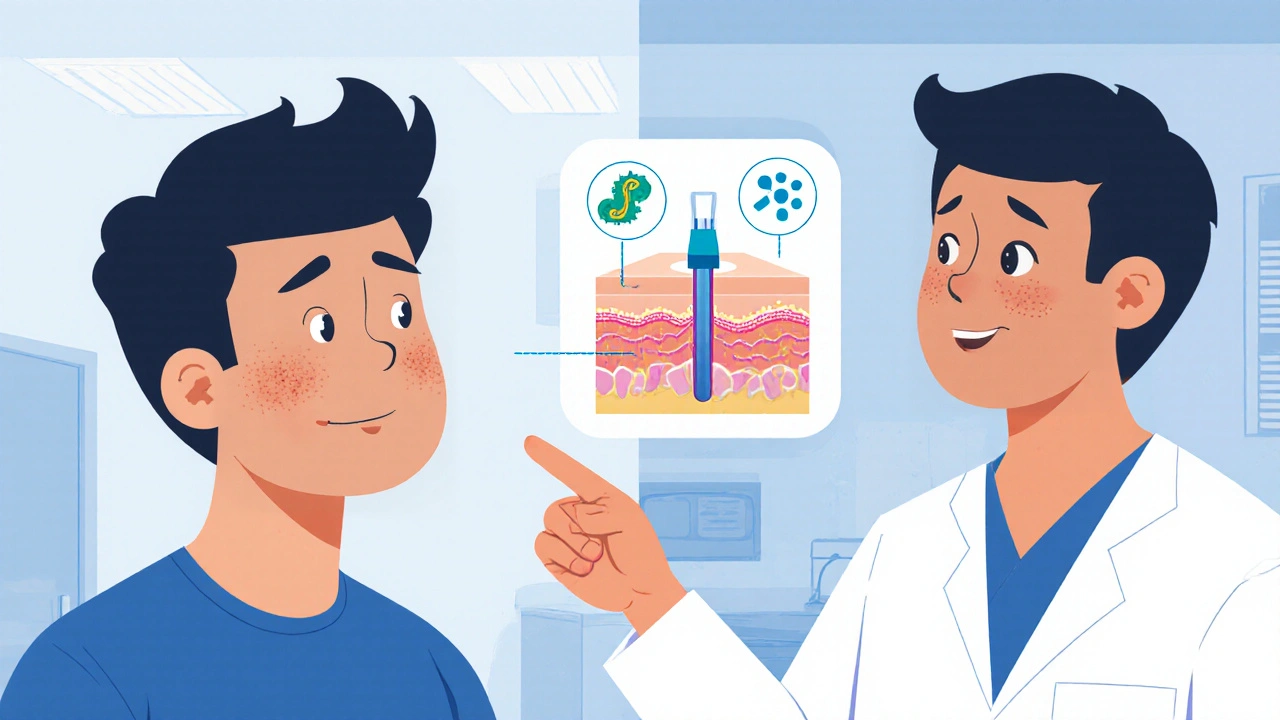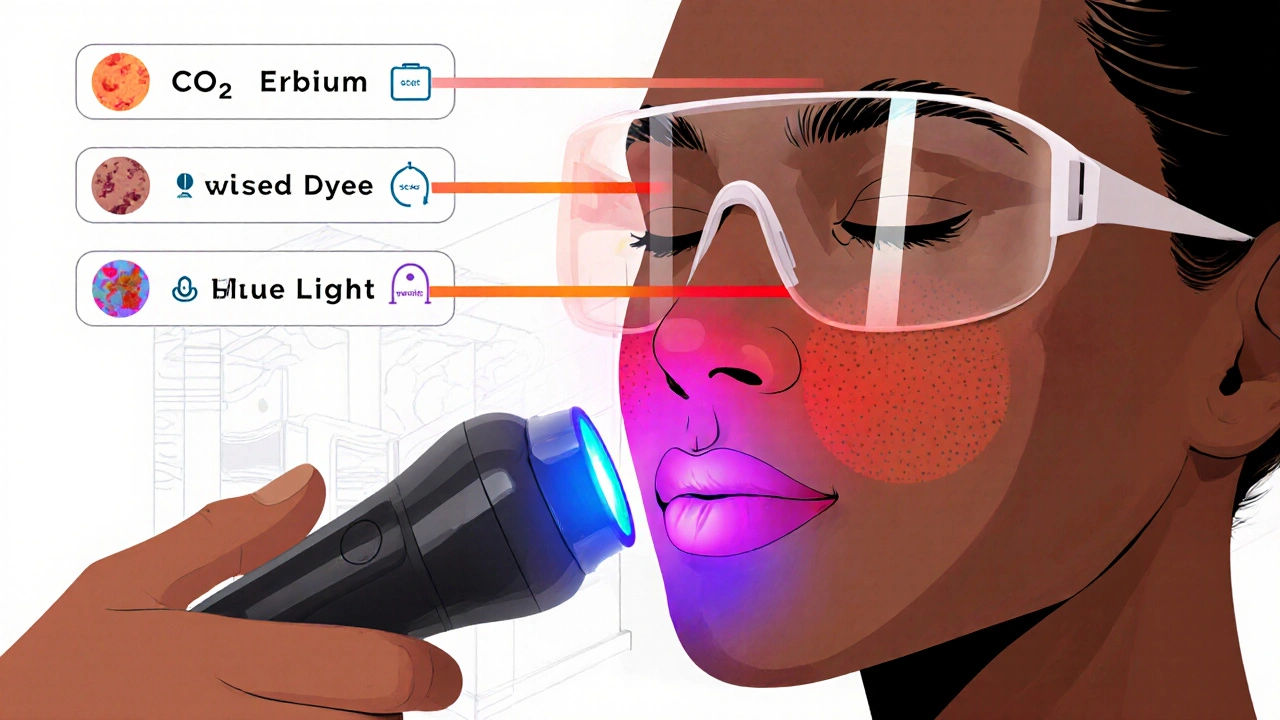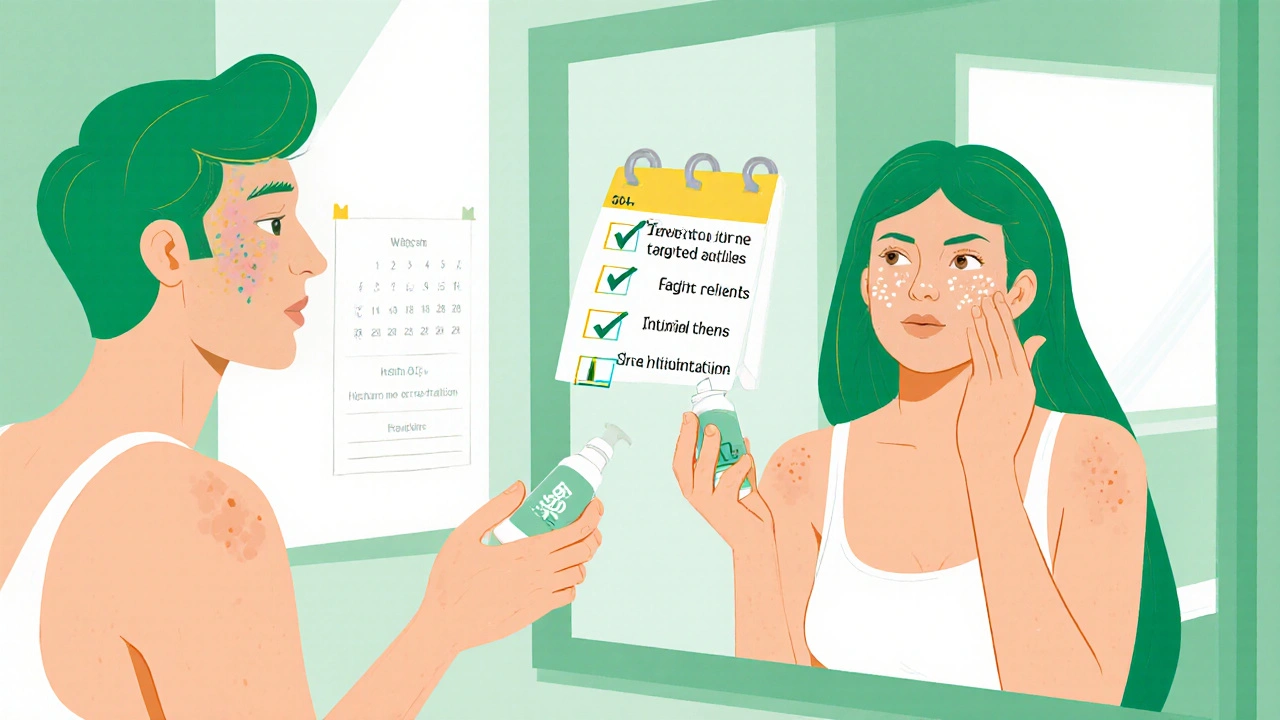Laser Therapy for Acne: Benefits, Risks & What to Expect
 Oct, 21 2025
Oct, 21 2025
Laser Therapy Acne Matchmaker
Find Your Laser Therapy Match
Tell us about your acne type and skin tone to get personalized laser treatment recommendations.
How It Works
We'll match your specific acne type and skin tone to the most appropriate laser therapy options based on dermatological guidelines. This tool doesn't replace a professional consultation, but it helps you understand what to discuss with your dermatologist.
Recommended Laser Therapies
Struggling with stubborn breakouts or lingering acne scars? Many people turn to laser therapy for acne hoping for clearer skin, but they’re not always sure what the procedure actually involves. This guide breaks down how the treatment works, who can benefit, what the session feels like, and how to care for your skin afterward.
How Laser Therapy Works for Acne
Laser Therapy is a targeted light treatment that uses specific wavelengths to destroy acne‑causing bacteria, shrink oil glands, and stimulate collagen remodeling. By delivering concentrated energy to the skin’s deeper layers, the laser heats up the sebaceous glands and kills the Propionibacterium acnes bacteria that thrive in oily pores. The heat also triggers a mild inflammatory response that jump‑starts the body’s natural healing process, leading to smoother, less oily skin over time.
Not all lasers are created equal. Some focus on vaporizing excess oil, while others target inflammation or scar tissue. The key is matching the right wavelength to the specific acne issue you’re battling.
Types of Lasers Used in Acne Treatment
Dermatologists can choose from a handful of laser technologies, each with its own strengths. Below is a quick comparison to help you see the differences.
| Laser Type | Wavelength | Primary Use | Typical Downtime | Average Cost (NZD) |
|---|---|---|---|---|
| CO2 Laser | 10,600 nm | Severe cystic acne, deep scarring | 5-7 days (redness, crusting) | 1,200-1,800 |
| Erbium Laser | 2,940 nm | Moderate acne, surface-level scars | 3-5 days (mild swelling) | 900-1,400 |
| Pulsed Dye Laser | 585-595 nm | Inflammatory (red) acne, rosacea‑like lesions | 1-2 days (temporary redness) | 600-1,000 |
| Blue Light Therapy | 415 nm | Active bacterial acne, mild to moderate | No downtime | 300-600 per session |
Choosing the right laser depends on your acne type, skin tone, and how much scar tissue you have. Your dermatologist will run a quick skin analysis-often using the Fitzpatrick scale-to gauge how your skin will react.
Who Should Consider Laser Therapy?
Laser treatment isn’t a one‑size‑fits‑all solution. It works best for people who:
- Have persistent inflammatory acne that hasn’t improved with topical or oral meds.
- Carry moderate to severe acne scars (ice‑pick, boxcar, or rolling).
- Are in good overall health and can tolerate a short procedure.
- Possess Fitzpatrick Skin Types I-III (lighter tones) for deeper lasers, or higher types (IV-VI) for gentler wavelengths like blue light.
Before booking, schedule a consultation with a board‑certified Dermatologist. They’ll evaluate your acne history, any hormonal factors, and whether you’ve tried conventional treatments first.

What to Expect During a Session
Most laser appointments last between 15 and 45 minutes, depending on the area being treated. Here’s a typical flow:
- Pre‑treatment prep: The clinician cleanses your skin and may apply a topical numbing cream if deeper lasers are planned.
- Safety check: You’ll wear protective eyewear while the practitioner sets the machine’s parameters (energy level, pulse duration).
- Laser delivery: The device emits short pulses across the acne‑prone zones. You’ll feel a snapping or warming sensation-similar to a rubber band snap.
- Post‑laser cooling: A cool gel or air‑flow system soothes the skin, reducing immediate redness.
- After‑care briefing: The provider outlines dressings, moisturizers, and any prescribed topical antibiotics or retinoids.
The entire process is painless for most people, though those with low pain thresholds might experience mild discomfort.
Recovery and After‑Care
Proper after‑care is where the magic happens. Follow these guidelines to maximize results and minimize side effects:
- Keep it clean: Wash the treated area with a gentle, fragrance‑free cleanser twice daily.
- Hydrate the skin: Apply a thin layer of a hyaluronic‑acid serum or a soothing aloe‑based gel to reduce dryness.
- Avoid Sun: UV exposure can worsen hyperpigmentation. Use a broad‑spectrum SPF 50+ for at least two weeks.
- No picking: Resist the urge to touch crusted spots; picking can trigger new scars.
- Skip harsh actives: Hold off on exfoliating acids, retinoids, or aggressive scrubs for at least a week.
- Follow medication plan: If your doctor prescribed oral antibiotics or topical benzoyl peroxide, complete the course.
Most people see a reduction in active lesions after 2-3 sessions, spaced 4-6 weeks apart. Visible scar improvement typically emerges after 4‑6 treatments.

Benefits vs. Risks
Like any medical procedure, laser therapy has pros and cons. Understanding both helps you make an informed decision.
Benefits
- Targeted action: Directly attacks the root cause-overactive oil glands and bacteria.
- Fast results: Many patients notice fewer breakouts after the first session.
- Scar reduction: Collagen remodeling smooths out shallow pits and improves skin texture.
- Minimal downtime (for light‑based lasers): Blue light or pulsed dye lasers let you return to work same day.
- Long‑term control: Repeated sessions can keep oil production in check for months.
Risks and Side Effects
- Transient redness, swelling, or a mild sunburn‑like feeling.
- Temporary hyper‑ or hypo‑pigmentation, especially in higher Fitzpatrick skin types.
- Rare scarring if the laser is set too high or if post‑care instructions are ignored.
- Infection risk if the skin isn’t kept clean after treatment.
Choosing a qualified provider and following after‑care instructions dramatically reduces these risks.
How to Choose the Right Provider
Not all clinics are equal. Use this checklist to vet potential professionals:
- Board certification in dermatology or plastic surgery.
- Specific experience with acne‑related laser procedures (ask for before‑and‑after photos).
- Transparent pricing and a clear treatment plan.
- Availability of a post‑procedure follow‑up appointment.
- Positive patient reviews that mention comfort, results, and recovery.
When you feel confident in the provider’s expertise, you’re more likely to stick with the recommended session schedule-and see the payoff.
Frequently Asked Questions
Does laser therapy cure acne?
It doesn’t "cure" acne permanently, but it dramatically reduces active breakouts and prevents new scars. Maintenance sessions every 6‑12 months keep results fresh.
How many sessions will I need?
Most patients see improvement after 2‑3 sessions for active acne and 4‑6 sessions for scar remodeling. Sessions are usually spaced 4‑6 weeks apart.
Is laser therapy safe for darker skin?
Yes, but the laser type matters. Lower‑energy blue light or pulsed dye lasers are preferred for Fitzpatrick Types IV‑VI to minimize pigment changes.
What should I avoid after treatment?
Skip direct sun, hot tubs, intense workouts, and abrasive exfoliants for at least a week. Keep moisturizers gentle and fragrance‑free.
Will the results be permanent?
Collagen changes are long‑lasting, but oil production can rise again with hormonal shifts or poor skincare. Periodic touch‑ups keep the skin clear.
Ready to take the next step? Book a consultation, ask about the laser options that suit your skin type, and set realistic expectations. With the right approach, laser therapy can be a game‑changer for stubborn acne and unwanted scars.

eric smith
October 21, 2025 AT 12:27Oh, so you finally discovered that lasers can zap pimples-what a groundbreaking revelation. Let me break it down for you: the machine isn’t a magic wand, it’s just a focused beam of light that heats up oil glands and kills bacteria. If you think a single session will turn you into a flawless Instagram model, you’re dreaming. The real kicker is that improper settings can leave you with more red spots than a fireworks show. So, before you book, maybe read the fine print instead of scrolling TikTok.
Ericka Suarez
October 28, 2025 AT 10:07THIS IS EXACTLY WHY WE SHOULD STOP TRUSTING CHEAP CLINICS! The whole thing feels like a sci‑fi movie, but with YOUR FACE as the set. I mean, “laser therapy” sounds sooo futuristic, yet they charge you like it’s a private jet. If you’re not from the U.S., you probably won’t get the same “top‑tier” equipment, and that’s just UNFAIR! It’s a tragedy that folks think they can just “snap” away acne without understanding the pain underneath.
Seriously, the risk of hyper‑pigmentation is real-don’t be an idiot and skip the sunscreen!
Jake Hayes
November 4, 2025 AT 08:47The protocol is clear: only qualified dermatologists should perform laser sessions, and patients must follow strict post‑care to avoid complications.
parbat parbatzapada
November 11, 2025 AT 07:27Sure, they tell you to "keep it clean," but who’s actually cleaning your pores? The clinics are probably spraying something that tracks your skin health for unknown purposes. And that "cooling gel"? Might just be a way to lull you into a false sense of safety while they harvest data from the device. Trust no one, especially when they promise "no downtime"-it’s a meme.
Casey Cloud
November 18, 2025 AT 06:07When considering laser therapy, start by evaluating your skin type and the specific acne concerns you have. Light‑based treatments work by targeting bacteria, oil glands, and inflammation, each requiring a different wavelength. For example, a pulsed dye laser is great for red, inflamed lesions while blue light is better for mild bacterial acne. You should schedule a consultation with a board‑certified dermatologist who can perform a Fitzpatrick skin assessment. This step helps avoid pigment changes that are more common in darker skin tones. Ask about the practitioner’s experience and request before‑and‑after photos of patients with similar skin types. Most clinics will recommend a series of treatments spaced four to six weeks apart. The reason for spacing is to allow the skin to heal and for collagen remodeling to take effect. During each session, a topical anesthetic may be applied, especially for deeper lasers like CO2 or Erbium. You’ll feel a snapping sensation that many describe as a rubber band snapping against the skin. Post‑treatment, the area will appear red and may feel warm, similar to a mild sunburn. Immediate care includes using a gentle cleanser and applying a soothing moisturizer or aloe gel. Sunscreen is non‑negotiable for at least two weeks, preferably a broad‑spectrum SPF 50+. Avoid picking at any crusted spots; doing so can create new scars. Skipping harsh actives like retinoids for a week is also advised to reduce irritation. Lastly, keep up with any prescribed topical antibiotics or oral meds to maximize results and prevent infection. Consistency with these after‑care steps is what turns a laser session into lasting improvement.
Rachel Valderrama
November 25, 2025 AT 04:47Wow, that was a marathon of advice-who needs a PhD when you’ve got this guide? If you actually follow every single step, you might just walk out of the clinic looking like a Hollywood star. Remember, the only thing that can stop your glowing skin is you forgetting the SPF. So, slap that sunscreen on like it’s the last piece of pizza and keep the confidence high.
Devendra Tripathi
December 2, 2025 AT 03:27Hold up, all that optimism ignores the fact that many laser devices are calibrated for profit, not precision. The industry pushes you to upgrade to the newest, most expensive machine, claiming better results, but the marginal benefit is often negligible. In reality, a decent blue‑light session can be as effective as a pricey CO2 laser for many patients, especially when you’re diligent with home care. Don’t let the hype dictate your budget.
Vivian Annastasia
December 9, 2025 AT 02:07Reading through the entire post feels like swimming in a sea of buzzwords-laser, collagen, Fitzpatrick-without any real soul. It’s as if the author tried to sound scientific while secretly hoping you’ll nod and click “book now.” The over‑emphasis on “board‑certified” just masks the fact that many clinics cut corners. If you’re looking for honest insight, you might have to look beyond the glossy brochure.
John Price
December 16, 2025 AT 00:47Looks like a solid rundown.
Nick M
December 22, 2025 AT 23:27In terms of cost‑benefit analysis, laser therapy presents a high upfront CAPEX with a variable ROI dependent on patient adherence to post‑procedure protocols. The marginal utility diminishes beyond three sessions for most moderate cases, aligning with the law of diminishing returns.